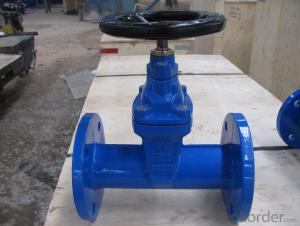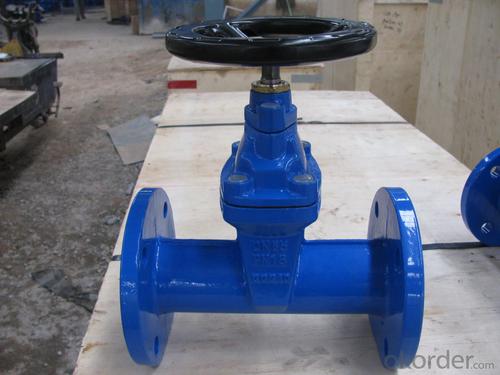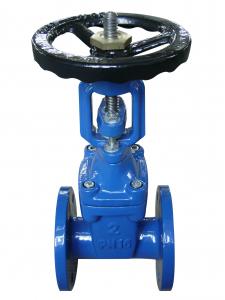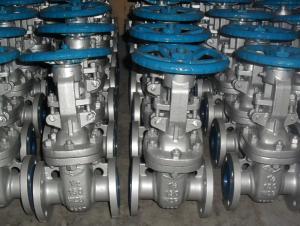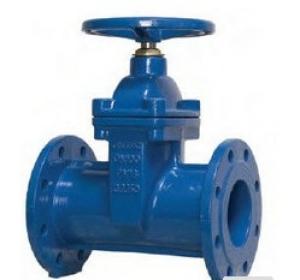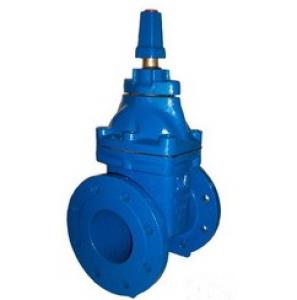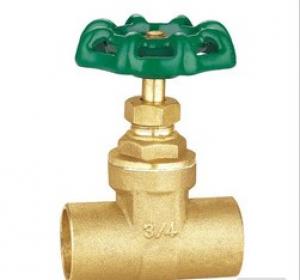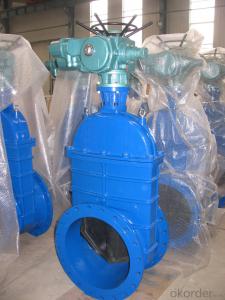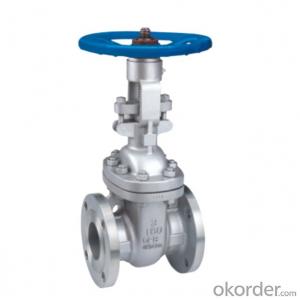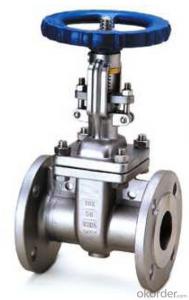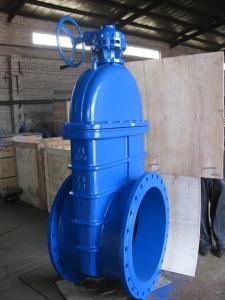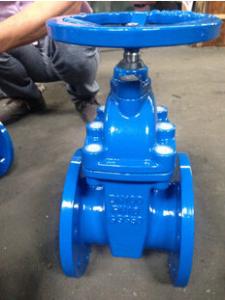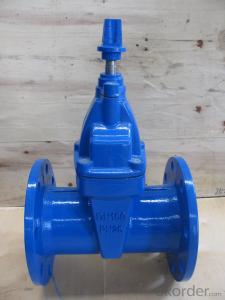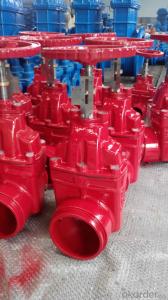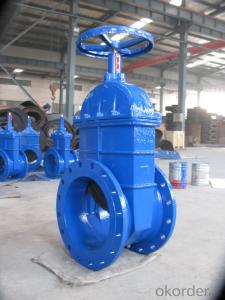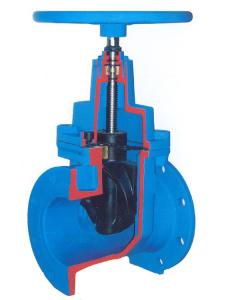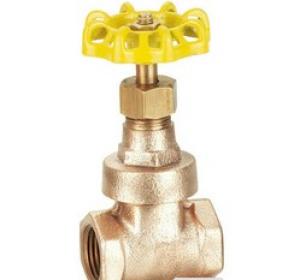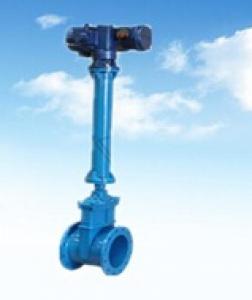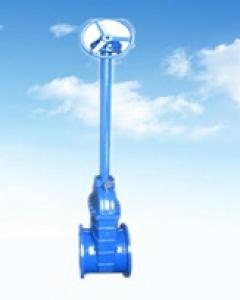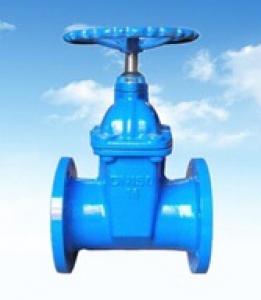Ductile Iron Gate Valve The new designs
- Loading Port:
- China main port
- Payment Terms:
- TT OR LC
- Min Order Qty:
- 100 PCS
- Supply Capability:
- 1000 PCS/month
OKorder Service Pledge
OKorder Financial Service
You Might Also Like
1.Structure of Gate Valve Description:
A gate valve, also known as a sluice valve, is a valve that opens by lifting a round or rectangular gate/wedge out of the path of the fluid. The distinct feature of a gate valve is the sealing surfaces between the gate and seats are planar, so gate valves are often used when a straight-line flow of fluid and minimum restriction is desired. The gate faces can form a wedge shape or they can be parallel. Gate valves are primarily used to permit or prevent the flow of liquids, but typical gate valves shouldn't be used for regulating flow, unless they are specifically designed for that purpose. Because of their ability to cut through liquids, gate valves are often used in the petroleum industry. For extremely thick fluids, a specialty valve often known as a knife valve is used to cut through the liquid. On opening the gate valve, the flow path is enlarged in a highly nonlinear manner with respect to percent of opening. This means that flow rate does not change evenly with stem travel. Also, a partially open gate disk tends to vibrate from the fluid flow. Most of the flow change occurs near shutoff with a relatively high fluid velocity causing disk and seat wear and eventual leakage if used to regulate flow. Typical gate valves are designed to be fully opened or closed.When fully open, the typical gate valve has no obstruction in the flow path, resulting in very low friction loss.
2. Main Features of the Gate Valve:
• Valve body cavity using non-toxic epoxy resin,both inside and outside flashboard completely is coated with rubber
• Free of water pollution
• High manufacturing accuracy
• High strength
• Environmental protection and energy saving
• Good visual effect
3. Images
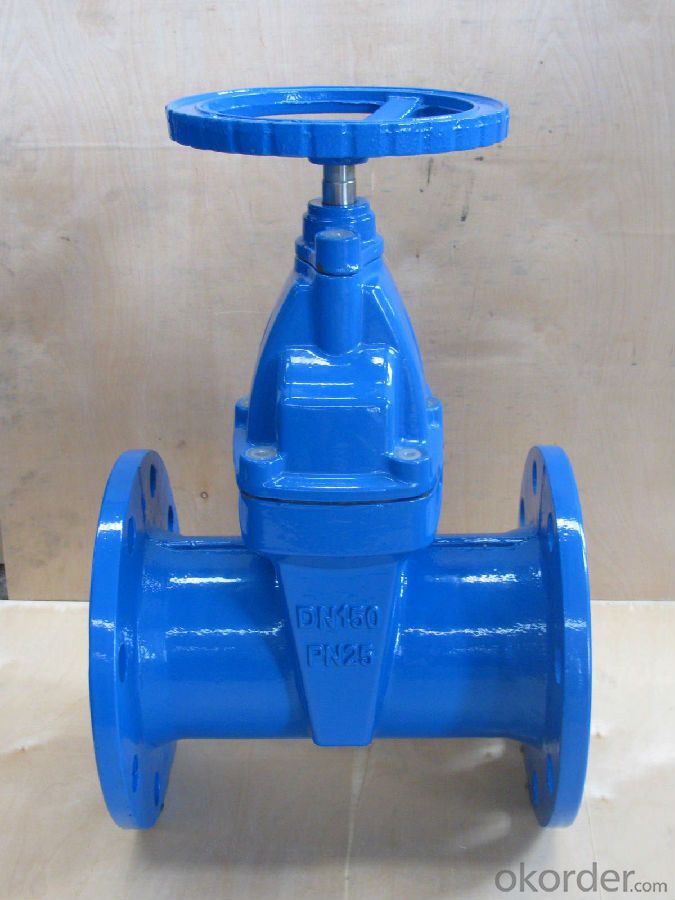
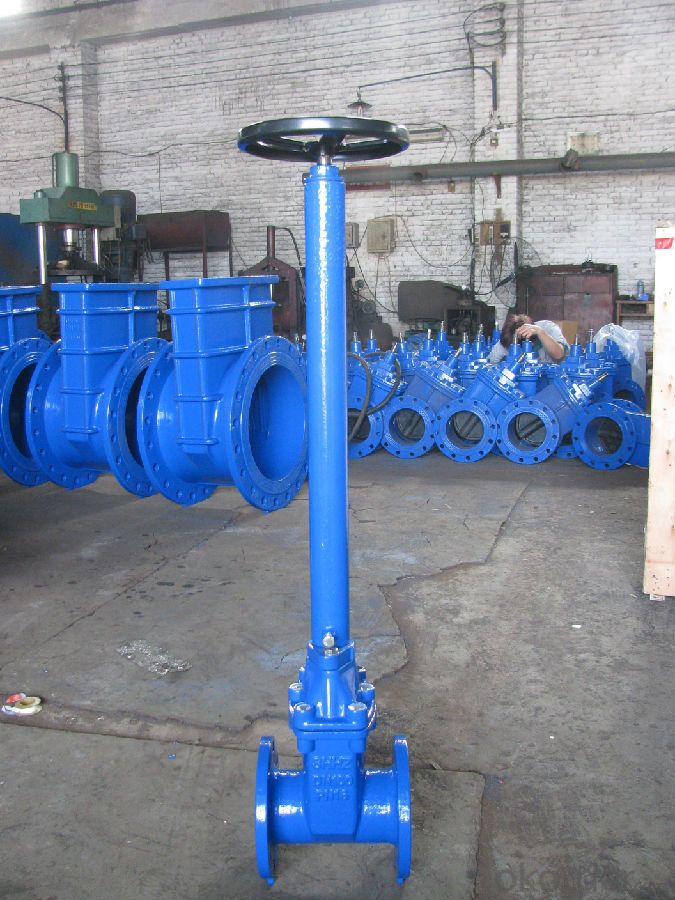
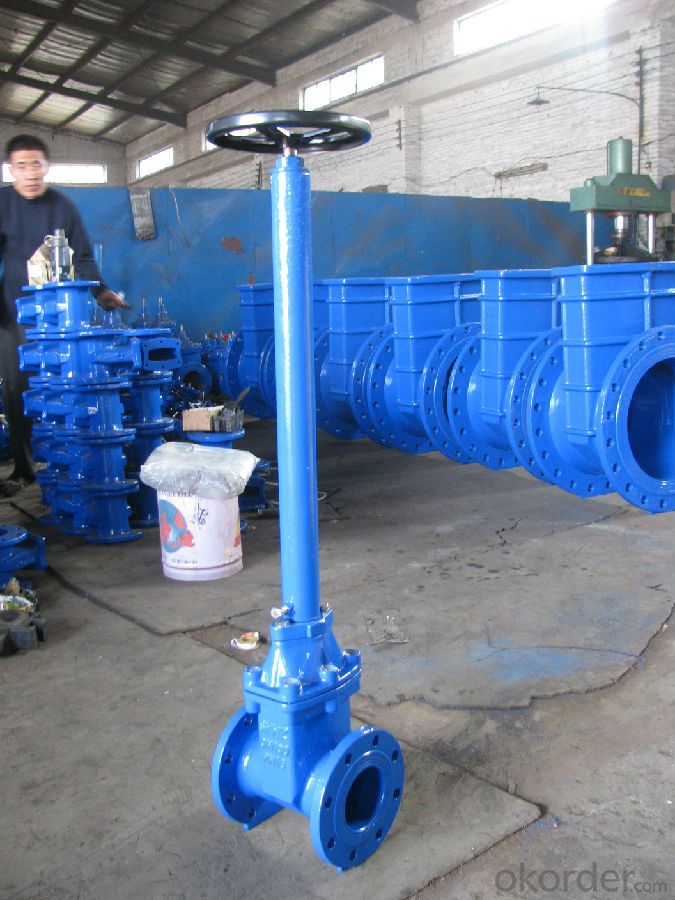
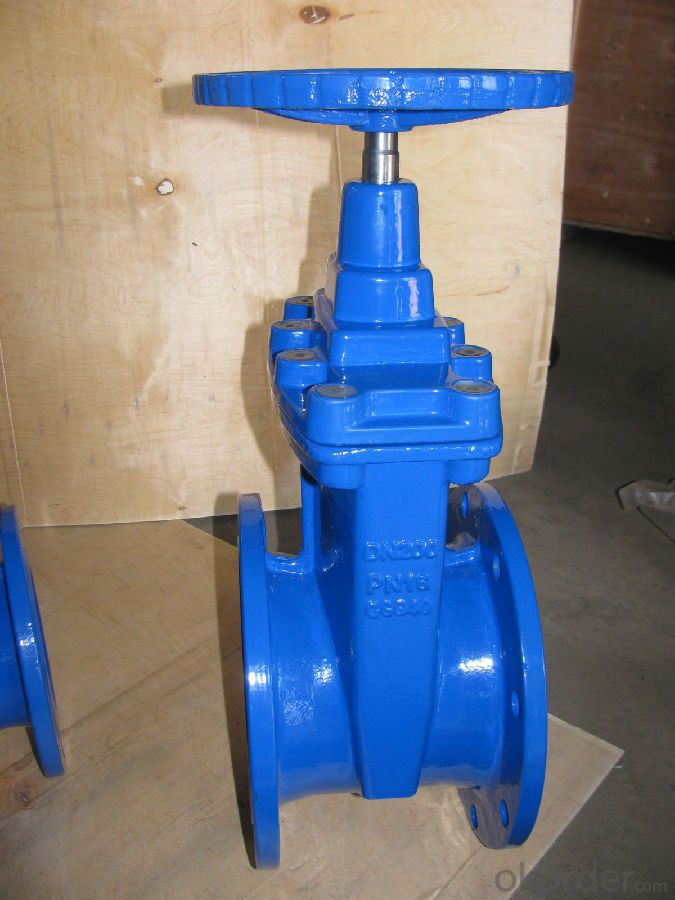
4. Gate valve Specification
Gate valve
Ductile iron gate valve
Flange Gate valve
Our company can produce all kinds of valves, If you have any inquiry, please contact us, we will offer you our best price.
1,good quality and competitive prices |
2,WRAS,CE,ISO 9001 approved. |
3,AKZO epoxy coating available |
Flanged ends according to BS,DIN,MSS,ANSI JIS |
Designed according BS,DIN,MSS,ANSI JIS |
Ductile Iron or Cast Iron body, bonnet and handwheel |
Cast iron wedge, NBR/EPDM coated |
Stainless steel stem, epoxy coating |
Test: BS,DIN,MSS,ANSI JIS |
5.FAQ
1. What's are the characteristics of gate valve?
The distinct feature of a gate valve is the sealing surfaces between the gate and seats are planar, so gate valves are often used when a straight-line flow of fluid and minimum restriction is desired. The gate faces can form a wedge shape or they can be parallel.
2. What is the work principle of gate valve ?
The gate faces can form a wedge shape or they can be parallel. Gate valves are primarily used to permit or prevent the flow of liquids, but typical gate valves shouldn't be used for regulating flow, unless they are specifically designed for that purpose. Because of their ability to cut through liquids, gate valves are often used in the petroleum industry.
3. What is the structure?
Bonnets provide leakproof closure for the valve body. Gate valves may have a screw-in, union, or bolted bonnet. Screw-in bonnet is the simplest, offering a durable, pressure-tight seal. Union bonnet is suitable for applications requiring frequent inspection and cleaning. It also gives the body added strength. Bolted bonnet is used for larger valves and higher pressure applications.
- Q: What is the soft seal gate valve?
- Cautions for installation and maintenance of soft sealing gate valve:For double gate valves, the direction of installation shall be in the vertical position of the valve stem, and the handwheel at the top.The installation of the soft gate valve shall be carried out in strict accordance with the installation environment, installation conditions and installation procedures on the factory manual.After installation, the soft seal gate shall be periodically checked for performance and killed in the cradle before any undesirable conditions occur.
- Q: The difference between flanged gate valve and common gate valve
- Flange gate valve and ordinary gate valve difference is that the flange gate valve of good quality, durable and easy to install, but the price is a little high, generally used for large pipelines. Common, also available, such as small caliber, easy to change places.
- Q: Why can't the pressure measuring point be set at the two ends of the gate valve when measuring the resistance loss of the gate valve?
- In the standard JB/T5296-1991 "universal valve flow coefficient and the flow resistance coefficient test method",
- Q: What's the difference between a soft seal gate valve and a hard sealed gate valve?
- The difference is that the form of the gate seal surface is different.General gate valves are generally leaking, easy to rust and other phenomena. Soft sealing gate valve (elastic seat sealing gate valve), gate material for cast iron lining rubber, overcome the shortcomings of the general gate valve, such as poor sealing, elastic fatigue, easy to rust, etc.. Soft sealing gate valve is a new product of the traditional gate valve.
- Q: What is the Z15T-16C letter of the gate valve?
- The Z class code indicates the type of gate valve, gate valve is the first letter of the alphabet. The gate is manual driving mode, 1 said the connection form of gate valve for connecting thread, 5 represents the structure form of gate valve for rigid single gate, T gate said lining material of copper alloy, 16 PN1.6MPa nominal pressure valve. C said the valve body material is carbon steel.
- Q: Which is the most expensive, check valve and gate valve?
- In the case of DN50 Z15T-16 DN50: screw valve 46.200 thread copper bar gate valve Z15T-16 DN50 52 Z45F-16 DN50 97 flange valve flange valve rod Z44T-10 DN50 169 Z45T-116 DN50 flange valve dark bar 173 thread swing check valves DN50 52.090 thread straight type check valve DN50 57.280 flange screw check H44T DN50 129 flange valve lift check valve H41T-16 DN50 124
- Q: What is wire feed gate valve? What do you say in French?
- It should be the wire gate valve. Refers to the valve body with internal thread or external thread, and pipe thread connection. Also called thread valves, threaded valves, valves within the toothFlange gate valve is connected to the flange gate valve, this connection is the most common wayThe main difference is the connectionI only know their English, I'm sorry I can't help youBox thread valveFlange valve
- Q: Fire protection gate valve from the wall how many distance there is no regulation?
- Don't know don't answer. "According to the provisions of article 6.2.13 GB50038-2005" code for design of basement for civil air defense engineering, into or through the door unit between the door closed wall should be set up in the inner side or two nominal pressure pipeline is not less than 1.0MPa, the spool is stainless steel or copper gate or globe valve water pipe from the air enclosure structure. The installation position from the wall should be not more than 200mm.
- Q: What are the standards for the execution of cast iron dark pole gate valves?
- They are also standard in the production of cast iron dark rod gate valves:Design and manufacture: as per GB/T12234-89 regulationsLength of structure: as specified by GB/T12221-89Flange dimensions: as specified in JB79 GB/T9112-9131Inspection and test: as specified in JB/T9092-99 GB/T13927-92Drive mode: manual, electric, gear drive
- Q: What does "Z45W-10T" mean?What does each letter stand for?
- T is the material code for the valve body, which stands for copper and copper alloysZ45W-10T, which means manual, flange connections, dark wedge rigid single gate plate, the valve seat sealing surface material directly processed by the valve body, nominal pressure PN10, valve body material for Brass Gate Valve
Send your message to us
Ductile Iron Gate Valve The new designs
- Loading Port:
- China main port
- Payment Terms:
- TT OR LC
- Min Order Qty:
- 100 PCS
- Supply Capability:
- 1000 PCS/month
OKorder Service Pledge
OKorder Financial Service
Similar products
Hot products
Hot Searches
Related keywords
